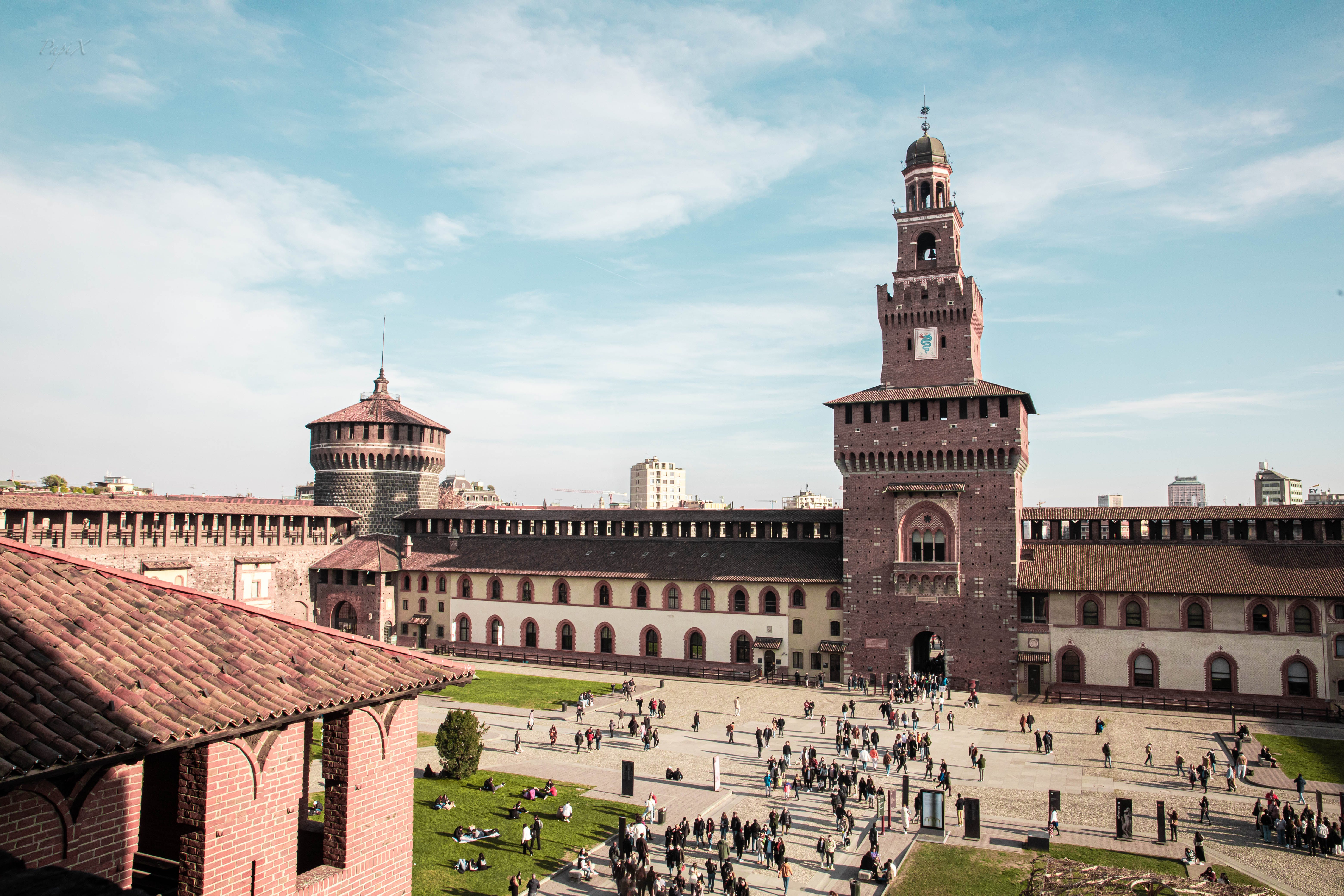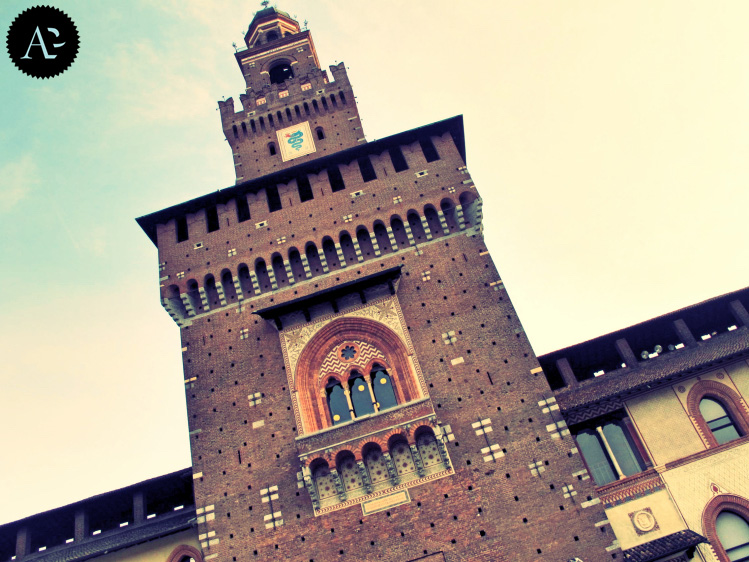
Milan is home to one of the largest castles in Europe, a veritable fortified citadel that now houses important museums and archives: the Castello Sforzesco. A stone’s throw from the historic center and Milan Cathedral, Castello Sforzesco is a dive into the city’s medieval past. In the many museums it houses, it is also possible to view works by leading artists in Italian art history and the Renaissance, such as Michelangelo, Leonardo da Vinci, and Antonello da Messina. To complete the picture of Renaissance Milan, then, it is possible to visit the famous Cenacolo vinciano, a unique and precious work preserved in the Refectory of the Convent of Santa Maria delle Grazie.
The history of the Castello Sforzesco

The history of Castello Sforzesco begins at the time of the ancient Romans: in fact, the Castrum Portae Jovis, one of the four defensive fortifications, stood here. The defensive function remained in the centuries to come, until the construction of the Castello Sforzesco that we can still admire today. It was commissioned in the 15th century by Francesco Sforza, who had recently become Duke of Milan.
Prominent in the castle’s architecture is the Filarete Tower, named after the Tuscan architect who designed it in the mid-15th century. Not even a century after its construction, however, it collapsed, and was rebuilt only in the early 20th century, taking up the original design with the addition of the clock with the symbols of the Sforza family.
Today, in addition to libraries, a bookstore and a visual arts center (CASVA), Castello Sforzesco houses:
- Pieta Rondanini Museum
- Museum of Furniture and Wood Carvings
- Archaeological Museum – Egyptian section, Prehistory and Protohistory section
- Museum of ancient art
- Museum of Decorative Arts
- Hall of Aces (Leonardo da Vinci)
- Museum of Musical Instruments
- Picture gallery: with works by Filippo Lippi, Antonello da Messina, Canaletto, Correggio, Tiepolo
Finally, inside the Castle are also several archives, most notably the Historical Archives and the Trivulziana Library, where the Trivulzian Codex, a collection of papers from 1478 to 1493 by Leonardo da Vinci, is kept.
Which ticket to buy for the Castello Sforzesco
To visit the Castello Sforzesco, the ticket can be purchased in advance; indeed, it is highly recommended because of the large influx of tourists that this once military and now museum complex attracts. A single ticket allows entry to the many museums that the castle houses, as well as access to the courtyards and gardens.
It is possible to purchase a ticket to Castello Sforzesco with a skip-the-line option, in which a digital audio guide is included, conveniently downloadable to your smartphone: in addition to accompanying you during your visit to the castle, the audio guide also includes information and routes about the city. Earphones and a mobile device are not included, and the audio guide is available in Italian, English, French, Spanish, and German.
The audio-guided tour lasts two hours, given the many attractions inside the Castle, and for entry just ask the staff in blue vests between the Filarete Tower and the fountain. Cancellation is free within 24 hours of the time booked for the visit.
MICHELANGELO’S LAST SCULPTURE AT THE SFORZESCO CASTLE
The so-called “Rondanini Pieta,” Michelangelo’s last sculpture, at the Castello Sforzesco since the 1950s, is the artistic testament of the brilliant Italian Renaissance painter, sculptor, architect and poet.
The ticket for a guided tour of the Castello Sforzesco and the Pietà Rondanini allows a visit to both together with a guide, and it is also possible to arrange the tour for private groups. The languages available for the tour are Italian, English, French, German, and Spanish, and earphones will be provided on site for up to eleven people. The tour is also suitable for wheelchair users.
Along with the sculpture are a medal made by Leone Leoni and depicting Michelangelo’s bust and a bronze mask obtained from Michelangelo’s wax death mask by his pupil Daniele da Volterra.
To visit the Pietà Rondanini and take a guided tour of the castle, the meeting point with the guide is under the Filarete Tower, also known as the Clock Tower. After the tour, which lasts an hour and a half, you can continue to visit the complex on your own, dwelling on the works found here or strolling through the courtyards and gardens. Finally, it is possible to cancel the guided tour with a refund of the ticket cost within 24 hours of the booked time.
Visita al Castello Sforzesco e al Cenacolo vinciano
La visita al Castello Sforzesco può essere abbinata a quella al Cenacolo vinciano, accedendo così a due luoghi storico-artistici espressione del Medioevo e del Rinascimento nel capoluogo lombardo.
Il biglietto per il Cenacolo e un tour guidato del Castello Sforzesco permette di saltare la coda e conoscere da una guida esperta la storia di questo dipinto, del Castello e dei suoi musei. Il tour dura due ore e trenta minuti, ma i visitatori possono poi continuare la visita in autonomia ed entrare nei musei non visitati con la guida, comunque compresi nel biglietto.
Il tour guidato del Cenacolo e del Castello Sforzesco vi permetterà di vedere il capolavoro di Leonardo nel Refettorio del Convento di Santa Maria delle Grazie insieme a una guida, che incontrerete proprio in Piazza di Santa Maria delle Grazie.
Il genio del Rinascimento ha realizzato questo dipinto con una tecnica particolare, stendendo il colore a secco sulla parete, invece che sull’intonaco bagnato, come per gli affreschi. Se questo gli ha consentito di lavorare più lentamente e di apportare delle modifiche, è anche la causa dei numerosi restauri e delle difficoltà nel mantenimento, oltre che dal numero contingentato di visitatori: vi si può entrare in piccoli gruppi, per un tempo stabilito e solo su prenotazione, per mantenere quanto più ottimali i parametri ambientali e favorire così la conservazione dell’opera.
La guida vi accompagnerà poi al Castello Sforzesco, dove vi soffermerete su alcuni musei ed opere in particolare (come la Pietà Rondanini). Il biglietto può essere annullato o riprogrammato entro 24 ore dalla visita, che è adatta anche a chi è in sedia a rotelle.

